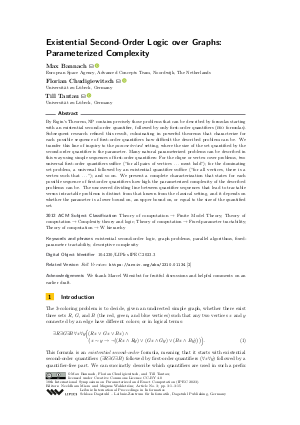Existential Second-Order Logic over Graphs: Parameterized Complexity
Authors
Max Bannach  ,
Florian Chudigiewitsch
,
Florian Chudigiewitsch  ,
Till Tantau
,
Till Tantau 
-
Part of:
Volume:
18th International Symposium on Parameterized and Exact Computation (IPEC 2023)
Part of: Series: Leibniz International Proceedings in Informatics (LIPIcs)
Part of: Conference: International Symposium on Parameterized and Exact Computation (IPEC) - License:
 Creative Commons Attribution 4.0 International license
Creative Commons Attribution 4.0 International license
- Publication Date: 2023-12-13
File

PDF
LIPIcs.IPEC.2023.3.pdf
- Filesize: 0.79 MB
- 15 pages
Document Identifiers
Related Versions
- Full Version https://arxiv.org/abs/2310.01134
Subject Classification
ACM Subject Classification
- Theory of computation → Finite Model Theory
- Theory of computation → Complexity theory and logic
- Theory of computation → Fixed parameter tractability
- Theory of computation → W hierarchy
Keywords
- existential second-order logic
- graph problems
- parallel algorithms
- fixed-parameter tractability
- descriptive complexity
Metrics
- Access Statistics
-
Total Accesses (updated on a weekly basis)
0PDF Downloads0Metadata Views
Abstract
By Fagin’s Theorem, NP contains precisely those problems that can be described by formulas starting with an existential second-order quantifier, followed by only first-order quantifiers (eso formulas). Subsequent research refined this result, culminating in powerful theorems that characterize for each possible sequence of first-order quantifiers how difficult the described problem can be. We transfer this line of inquiry to the parameterized setting, where the size of the set quantified by the second-order quantifier is the parameter. Many natural parameterized problems can be described in this way using simple sequences of first-order quantifiers: For the clique or vertex cover problems, two universal first-order quantifiers suffice ("for all pairs of vertices ... must hold"); for the dominating set problem, a universal followed by an existential quantifier suffice ("for all vertices, there is a vertex such that ..."); and so on. We present a complete characterization that states for each possible sequence of first-order quantifiers how high the parameterized complexity of the described problems can be. The uncovered dividing line between quantifier sequences that lead to tractable versus intractable problems is distinct from that known from the classical setting, and it depends on whether the parameter is a lower bound on, an upper bound on, or equal to the size of the quantified set.
Cite As Get BibTex
Max Bannach, Florian Chudigiewitsch, and Till Tantau. Existential Second-Order Logic over Graphs: Parameterized Complexity. In 18th International Symposium on Parameterized and Exact Computation (IPEC 2023). Leibniz International Proceedings in Informatics (LIPIcs), Volume 285, pp. 3:1-3:15, Schloss Dagstuhl – Leibniz-Zentrum für Informatik (2023)
https://doi.org/10.4230/LIPIcs.IPEC.2023.3
BibTex
@InProceedings{bannach_et_al:LIPIcs.IPEC.2023.3,
author = {Bannach, Max and Chudigiewitsch, Florian and Tantau, Till},
title = {{Existential Second-Order Logic over Graphs: Parameterized Complexity}},
booktitle = {18th International Symposium on Parameterized and Exact Computation (IPEC 2023)},
pages = {3:1--3:15},
series = {Leibniz International Proceedings in Informatics (LIPIcs)},
ISBN = {978-3-95977-305-8},
ISSN = {1868-8969},
year = {2023},
volume = {285},
editor = {Misra, Neeldhara and Wahlstr\"{o}m, Magnus},
publisher = {Schloss Dagstuhl -- Leibniz-Zentrum f{\"u}r Informatik},
address = {Dagstuhl, Germany},
URL = {https://drops.dagstuhl.de/entities/document/10.4230/LIPIcs.IPEC.2023.3},
URN = {urn:nbn:de:0030-drops-194224},
doi = {10.4230/LIPIcs.IPEC.2023.3},
annote = {Keywords: existential second-order logic, graph problems, parallel algorithms, fixed-parameter tractability, descriptive complexity}
}
Author Details
Acknowledgements
We thank Marcel Wienöbst for fruitful discussions and helpful comments on an earlier draft.
References
-
Sanjeev Arora and Boaz Barak. Computational Complexity - A Modern Approach. Cambridge University Press, 2009.

- Max Bannach, Florian Chudigiewitsch, and Till Tantau. Existential second-order logic over graphs: Parameterized complexity. Technical Report abs/2310.01134, Cornell University, 2023. URL: https://arxiv.org/abs/2310.01134.
- Max Bannach, Christoph Stockhusen, and Till Tantau. Fast parallel fixed-parameter algorithms via color coding. In 10th International Symposium on Parameterized and Exact Computation, IPEC 2015, September 16-18, 2015, Patras, Greece, pages 224-235, 2015. URL: https://doi.org/10.4230/LIPIcs.IPEC.2015.224.
- Max Bannach and Till Tantau. Computing kernels in parallel: Lower and upper bounds. In 13th International Symposium on Parameterized and Exact Computation, IPEC 2018, August 20-24, 2018, Helsinki, Finland, pages 13:1-13:14, 2018. URL: https://doi.org/10.4230/LIPIcs.IPEC.2018.13.
- Paul Beame, Russell Impagliazzo, and Toniann Pitassi. Improved depth lower bounds for small distance connectivity. Comput. Complex., 7(4):325-345, 1998. URL: https://doi.org/10.1007/s000370050014.
-
J. Richard Büchi. Weak second-order arithmetic and finite automata. Zeitschrift für mathematische Logik und Grundlagen der Mathematik, 6(1-6):66-92, 1960.

- Yijia Chen and Jörg Flum. Some lower bounds in parameterized ac^0. In 41st International Symposium on Mathematical Foundations of Computer Science, MFCS 2016, August 22-26, 2016 - Kraków, Poland, pages 27:1-27:14, 2016. URL: https://doi.org/10.4230/LIPIcs.MFCS.2016.27.
- Bruno Courcelle and Joost Engelfriet. Graph Structure and Monadic Second-Order Logic - A Language-Theoretic Approach, volume 138 of Encyclopedia of mathematics and its applications. Cambridge University Press, 2012. URL: http://www.cambridge.org/fr/knowledge/isbn/item5758776/?site_locale=fr_FR.
- Rodney G. Downey and Michael R. Fellows. Parameterized Complexity. Monographs in Computer Science. Springer, 1999. URL: https://doi.org/10.1007/978-1-4612-0515-9.
-
Heinz-Dieter Ebbinghaus, Jörg Flum, and Wolfgang Thomas. Mathematical logic (2. ed.). Springer, 1994.

- Thomas Eiter, Yuri Gurevich, and Georg Gottlob. Existential second-order logic over strings. J. ACM, 47(1):77-131, 2000. URL: https://doi.org/10.1145/331605.331609.
-
Ronald Fagin. Generalized first-order spectra and polynomial-time recognizable sets. Complexity of Computation, 7:43-74, 1974.

- Jörg Flum and Martin Grohe. Parameterized Complexity Theory. Springer, 2006. URL: https://doi.org/10.1007/3-540-29953-X.
- Fedor V. Fomin, Petr A. Golovach, and Dimitrios M. Thilikos. On the parameterized complexity of graph modification to first-order logic properties. Theory Comput. Syst., 64(2):251-271, 2020. URL: https://doi.org/10.1007/s00224-019-09938-8.
- Georg Gottlob, Phokion G. Kolaitis, and Thomas Schwentick. Existential Second-Order Logic Over Graphs: Charting the Tractability Frontier. Journal of the ACM, 51(2):312-362, 2004. URL: https://doi.org/10.1145/972639.972646.
-
Christos H. Papadimitriou. Computational complexity. Addison-Wesley, 1994.

- Till Tantau. Existential second-order logic over graphs: A complete complexity-theoretic classification. In 32nd International Symposium on Theoretical Aspects of Computer Science, STACS 2015, March 4-7, 2015, Garching, Germany, pages 703-715, 2015. URL: https://doi.org/10.4230/LIPIcs.STACS.2015.703.
